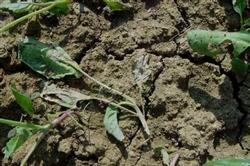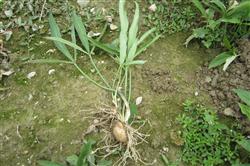Planting technique of Pinellia ternata: what is Pinellia ternata quenching disease?

What is pinellia cataplexy? What harm does cataplexy have to Pinellia ternata? How to prevent and cure the disease of Pinellia ternata? Hope that some netizens can help introduce the disease of Pinellia ternata, also known as leaf scalding disease, the harm and prevention methods of Pinellia ternata are listed in detail below (for reference). The harm of quenching disease of Pinellia ternata: quenching disease is one of the most common diseases in artificial planting Pinellia ternata, and its cause is being studied and observed. It is most likely to occur in the high temperature and rainy season and high humidity, especially when the ventilation and light transmission is poor, the disease is serious. In the early stage of the disease, green irregular disease spots appeared on the leaves and petioles, then the color of the disease spots deepened, the affected parts became soft, and the leaves were like boiling water, drooping in a translucent manner and sticking to each other. The disease of Pinellia ternata is acute and contagious. Once it is found, it spreads quickly and treats the trouble. The soil and air of the whole plot gave off a strong fishy smell. Prevention and control methods of Pinellia ternata quenching disease: method 1. When selecting Pinellia ternata planting plots, we should choose the old vegetable fields where tomatoes, eggplants, cucumbers and cabbages have not been planted in the previous crop, or the plots where the crops in this field have not experienced quenching disease. Method 2. In rainy season and high temperature season, attention should be paid to reducing soil moisture. Method 3. After the soil is selected, winter ploughing and drying should be carried out in winter. Do not apply immature fertilizer, properly apply or do not apply nitrogen fertilizer in chemical fertilizer. Method 4. After the high temperature and rain before onset, 75% chlorothalonil 1000 times solution; agricultural 200ppm streptomycin and neoptomycin; chloramphenicol of 300ppm; once every 7 days, alternately sprayed 3 times. Pay attention to spray evenly, so that do not re-spray, do not leak. Method 5, spray control with 66.5% Prik 800 times, 72% DuPont Klou 500 times, the effect is also good. Click to get more planting techniques of Pinellia ternata
- Prev

Planting techniques of Pinellia ternata: how to manage dry Pinellia ternata in winter?
How to manage Pinellia ternata in winter? There are no experienced netizens please give guidance to enter the winter, dry Pinellia ternata winter management if poor management, will directly affect its output and quality. Therefore, it is very important to strengthen its winter management. The following farming network lists the management methods of dry Pinellia ternata and winter for everyone.
- Next

Planting techniques of Pinellia ternata: what are the diseases and insect pests of Pinellia ternata?
What are the diseases and insect pests of Pinellia ternata? How to control diseases and insect pests in Pinellia ternata? Ask netizens to help introduce the diseases and insect pests of Pinellia ternata, such as root rot, virus disease and red diamondback moth; detailed control methods can be listed below: 1. Root rot harm and control methods: root rot is easy to occur in high temperature season and stagnant water in the field.
Related
- Fuxing push coffee new agricultural production and marketing class: lack of small-scale processing plants
- Jujube rice field leisure farm deep ploughing Yilan for five years to create a space for organic food and play
- Nongyu Farm-A trial of organic papaya for brave women with advanced technology
- Four points for attention in the prevention and control of diseases and insect pests of edible fungi
- How to add nutrient solution to Edible Fungi
- Is there any good way to control edible fungus mites?
- Open Inoculation Technology of Edible Fungi
- Is there any clever way to use fertilizer for edible fungus in winter?
- What agents are used to kill the pathogens of edible fungi in the mushroom shed?
- Rapid drying of Edible Fungi

